2008 VOLKSWAGEN JETTA seats
[x] Cancel search: seatsPage 185 of 477
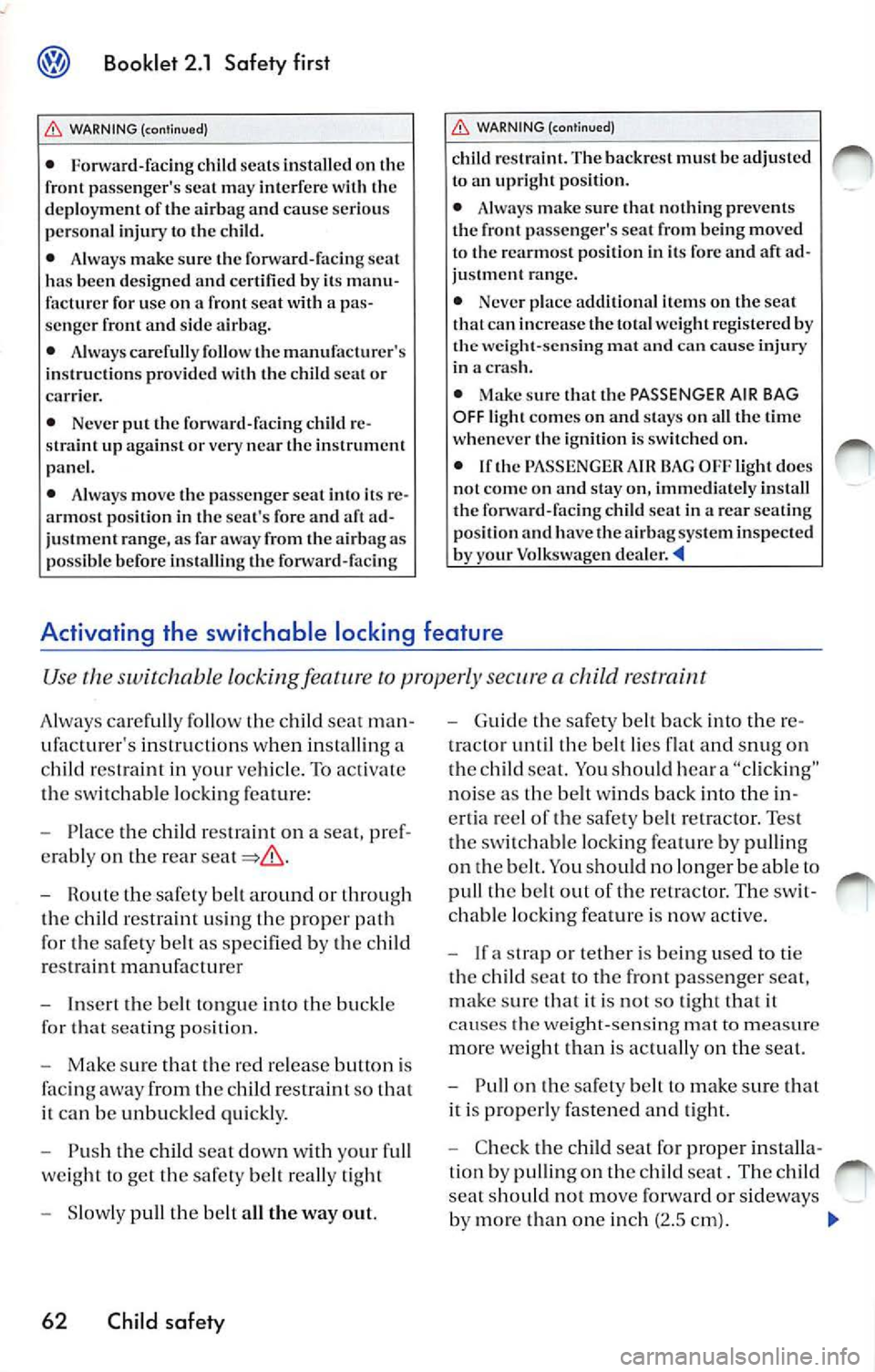
Booklet 2.1 Safety first
WARNING (continu ed)
• Forward-facin g child seats installed on the
fr ont passe nger's sea t may interfer e with the
d e plo ym ent of
airba g an d cause seriou s
per sonal injury to the ch ild.
• Always make sur e th e fo rwa rd-fa cing sca t
h as bee n de sig n ed and certifi ed by its manu
facturer for use on a front seat with a pas
se nge r front and sid e ai rbag.
• Always carefully foll ow the manufa ctur er's
in structi ons pro vided with th e c hild seal or
ca rri er.
• Never put the fon vard -facing child r e
stra int up against or very near the instrum ent
panel.
• Always move the passenge r sea t int o its re
armost pos ition in the sea t's fore and aft ad
ju stment range, as far away from the airba g as
p ossible before installing the for ward-faci ng
WARN ING (cont inued)
child restraint. The backrest must be adjusted
t o an upr ig ht position .
• Always make sure that nothin g preve nts
t h e front passenger's sea t from bei ng m oved
to th e rearmos t position in it s fore and aft ad
ju stm ent rang e.
• Never place additional items on th e seat
that can in crease the total weight reg is tere d by
the weig ht-se nsin g mat and can ca use inju ry
in a cras h.
• Make s ure that the
PASSENGER AIR BAG OFF light comes on an d sta ys on all th e tim e
w hen ever the ig nition i s switch ed on.
• If th e PASSENGER
BAG OFF light doc s
n o t come on and stay on , imm ediately insta ll
t he forward -faci ng ch ild sea t in a rear seating
po sition and have the air bag sys tem inspected
b y yo ur Volkswagen dealer.
Activating the switchable locking feature
Us e the switchable Locking feature to properly secure a child restraint
Always ca refully fo llow t he c hild sear man
u fac turer's instruct io n s w hen insta lling a
c hild res tra int in yo ur vehicle .
To activat e
th e sw itch able lock ing fe a ture:
- Pla ce the ch ild res train t on a sea t, pref
erab ly o n the rear
- Route the safe ty belt around or th rough
the child restra int usi ng the proper path
for the sa fety be lt as speci fied by the child
re stra int manu facturer
- In se rt the belt tongu e into the buckle
fo r that seat ing po siti on.
- Make su re th at the red re lease button is
faci ng away from th e child restra int so that
it ca n be unbuckled quickly .
- Push the c hild sca t do wn w it h your full
we ig ht t o get the sa fety belt rea lly tight
- S low ly pull the belt all the way out.
62 Child safety
-Guide th e safety be lt b ack int o the re
t ractor un til the be lt lies fla t and snu g on
the ch ild se at. You sho uld hea r a "c lick ing"
n o ise as t he be lt wi nds back into th e in
ert ia reel of t he safety belt re tr actor. Tes t
the switch able locking featu re by pulli ng
on th e bc l
l. You should n o longer be ab le to
pull the b elt o ut of t he re tra ctor. The swit
c habl e lock ing feature is now act ive.
-
s trap or teth er is being used to tie
th e ch ild sea t to th e front passe nger seat,
mak e sur e th at it is not so tight that it
cau ses the weig h t-s en sin g ma t to m eas ure
m ore we ig h t than is actua lly on th e sea t.
- Pull on the safety belt to make sure th at
it is prope rly fastened and tight.
- Chec k th e c hild seat for prope r install a
ti on by pu llin g on the c hild seat. The child
sea t sh ou ld no t mo ve forward or sid eways
b y m ore than one in ch (2.5 cm) .
Page 187 of 477
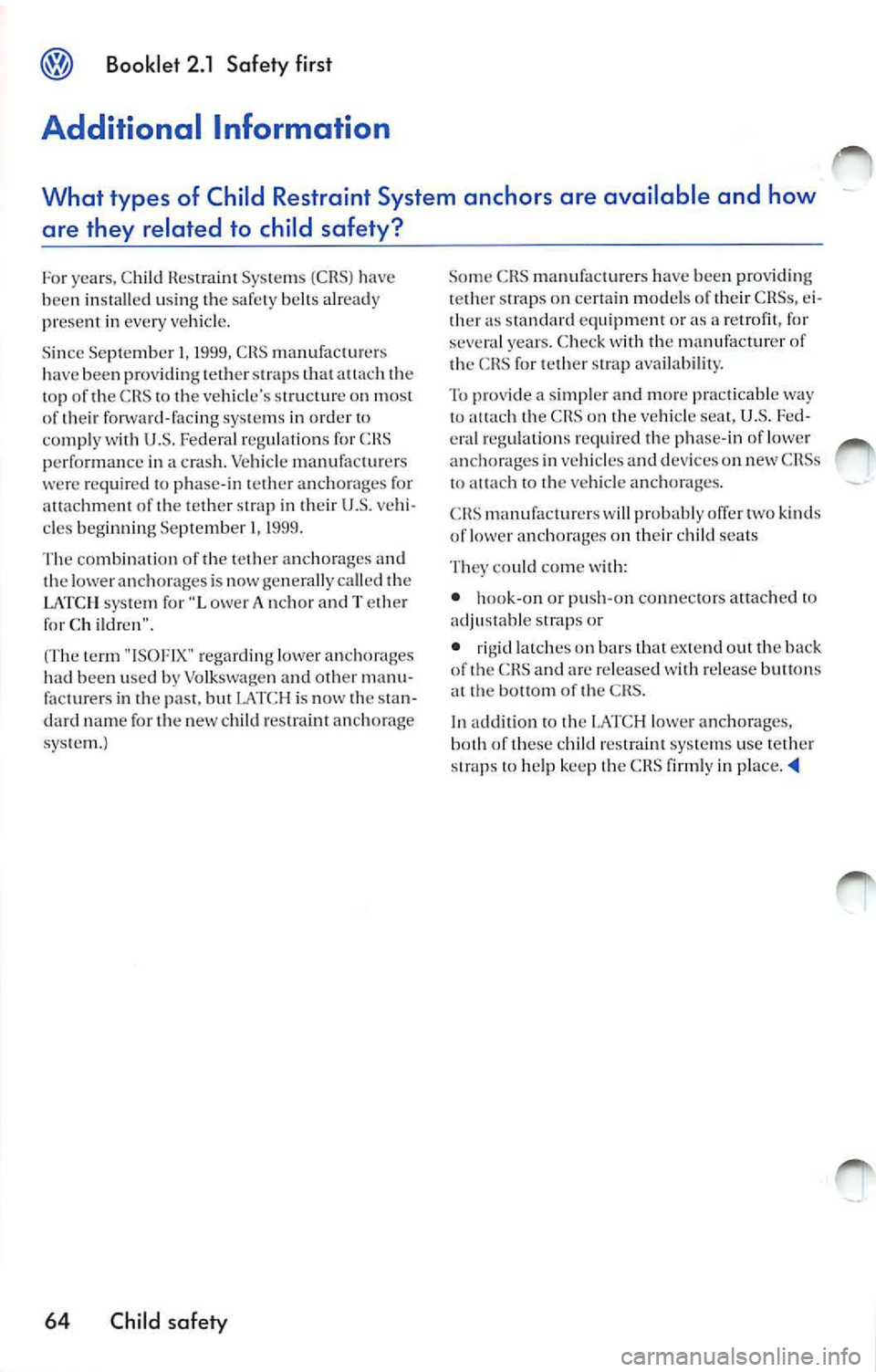
Booklet 2.1 Safety first
Additional Information
What types of Child Restraint System anchors are availabl e and how
are they related to child safety?
For years , C hild Restrai nt Sys te m s (C RS) have
b ee n in sta lled us ing the safety belts already
pr ese nt in every ve hicle.
S in ce September
1999, CHS man ufac turers
h ave been providing tet her s traps tha t attach the
top of the C RS to the vehicl e's s tructure on mo st
of th eir forwa rd-fac ing syste m s in order to
co mp ly with U.S. Federal re gulation s for
ens perfo rmance in crash . Ve hicle manu fac tur ers
were req uir ed to p hase -in tether a nchorag es fo r
a tta chm ent of the tet her
in th eir U. S. ve hi
cl es beg innin g September 1999.
The combination of the teth er an cho rages and
the lower anch orages is no w generally ca lled the
LATCH syste m for " Lower Anch or and Tethe r
for Childr en".
(T he t erm
rega rdin g lower anc ho ra ges
had bee n use d by Volkswagen a nd other manu
facture rs in the past, but LATC H is now the stan
dard nam e for the ne w child res traint anchorag e
sys te m .)
64 Child safety
Some C HS manufa ctur ers have been providin g
t e th er straps on certa in mod els o f their CHSs, ei
th er as sta ndard equi pment or as a retrofit, for
seve ral years. Chec k w ith the manufacturer of
th e CRS for te th er stra p availab ility.
Tu provide a simpl er and mor e prac ticable
to attac h th e ens on the ve hicle U.S. Fed
eral reg ulations req uired the pha se- in of lowe r
anchorages in vehicles and d evices on new CRSs
to attach to t he ve hicle a nch orages.
CRS man ufa ctur ers w ill prob ably offer
kin ds
of lower an ch orages o n their c hild seats
T hey co uld come w ith:
• hook-on or p ush -on con nec tor s attach ed to
adj ustable strap s or
• rigid l atches o n bars
exte nd out the ba ck
o f the and a re release d with re lease buttons
at the bo ttom of the
In addition to the LATCH lowe r anchorag es,
both of these child r estrain t systems use teth er
he lp kee p th e C HS firm ly in
Page 193 of 477

Booklet 2.1 Safety first
Releasing
- Loo sen th e te nsio n on th e stra p fo l
lo wing the CRS manufacturer's in struc
ti on s
- Depre ss the spring catc h on the hook.
- Hold th e spr ing catch in th e depr ess ed
po siti on.
- Move the hook in direct io n of the
ve
hicle floor so that th ere is enough spa ce to
r e le a se th e co nnector from th e lower an
c hora ge.
- Rele a se the tether strap
WARNING
Imp roper use of the LATCH system can in
crease the risk of serious personal injury and
death in an accide nt.
WARNING (continued )
• These anchors were developed solely for
c hild seals using the "LATCH" system.
• Never allach other child seats, belts or
o th er obj ects lo these an chor s.
• Alwa ys make sure that you hear a click
when latchin g the seat in pl ace. If you do not
h ea r a cli ck th e seal is not secure and cou ld fly
forward and
the interior of the vehicle, or
be ejec ted from the vehicl e.
WARNING
Improp er installation of child restraint s will
increase the ri sk of injur y in an accident.
• Alw ays follow the
manufacturer's in
s tru ction s for prop er in stallation of the
and prop er use te ther strap s as well as the
l owe r an chorages or safe ty belts in your ve
hicl e.
• Alway s read and heed th e important infor
mation and WARNINGS about ch ild safety and
the installation of CRSs
51, "Child
s afety ".
Where can I get additional information about child
restraints and their use?
There are numb er of so urces of additiona l in
for mation ab o u1 se )ec 1ion, insta lla tion and
u se :
N HTSA advises that the bes t child safety
i s
t h e o ne fits your child and fits in your ve
hi cle, a nd that you will u se c orrectly and consis
tent ly.
Tr y before you bu y!
National Highwa y
Safe ty Adm inistration
Tel.: (888) DAS H-2 -DOT
www.nh tsa. dot.gov
P rog ra m Profess io nals
T e l.: (734) 324-7550
70 Child safety
W\vw.prog ramprofessionnls.org
N ational SAFE KIDS Campaign
Te l.: (202) 662-0600
WW\V.safek ids.o rg
Sa fet y BeltSafe U.S .A
T el. : (800 ) 745-SA FE (E nglish )
Te l.: (80 0) 74 7-SANO (Spa nish)
www .carsea t.o rg
Volk swa gen Custo m er C AHE
T e l.: (800) 822-8987
Tran sport Canada
Te l.: (8 88) 675-6863
www. tc .gc .ca
Page 194 of 477

Alphabetical index
A
Acoustic sig nal 14
Ac tivatin g th e sw itchabl e locking featu re 62
A ddress of NHTSA 1 2
Adjusting safety belt height 24
Adva nced Airb ag Sys tem 3 1
A irb ag dep loymen t zo ne 37
Ho w the compo nen ts wo rk toge th er 35
Adva nced A irbag Sys te m compon ent s 34
Adva nced front airbag syste m 32
A irbag dep loy me nt zone 37
A irba g syste m 27
C ar e 42
Co mpone nts (fro nt airbag s) 34
Co mpone nts (s id e a ir bags) 44
Co mpon en ts (s ide curta in
c hi ld sea t o n t he front
passenger seat 29
Disposal 42
F ro nt airbags 31
Ho w it wo rks? 46, 49
How m any a irbags does my ve hicle
ha ve? 34,
49
Importance of sittin g properly 27
I mportance of wearing safety be lts 27
I mportant thing s
know 27
Indicator light 39
Mo nitor in g 39
PASSENGER
BAG OFF li ght 39
Repai rs 42
S ide airbags 44
W hen mu st the sys te m b e inspected? 39
W here are my a irba gs located? 31, 44, 48
Auto Safety Hotli ne 12
A ut omatic belt r etr ac tor 19
B
Before driv in g 3
Belt p rete nsio ner
D is p osal 26
Service 26
Booster seats 59
Booklet 2 .1 Saf ety first
T et her an chor s 65
Tether strap 65
C onve rtibl e child seats 57
Curtain a irbags 48
C ustome r CARE Ce nter 27
D
Danger offitting a child seat o n the front pas
se nge r sea t 29
D eact iva ting th e swit c hab le lo cking
f ea tur e 63
Dis ta n ce between drive r and steer ing
whee l 4
Dr iver
See Sea ting p osition
Driving safety 3
Dr iv in g w ith childr en 51
E
Examples of imp roper sea ting positions 8
Ext end er for th e s afe ty belts 22
F
Faste nin g
B oos ter sea ts 59
Conve rtible c hild sea ts 57
Infant seats 56
Safety belt extende r 23
Safety belt s 19
Flo or mats 9
Alphabetical inde x 71
Page 196 of 477
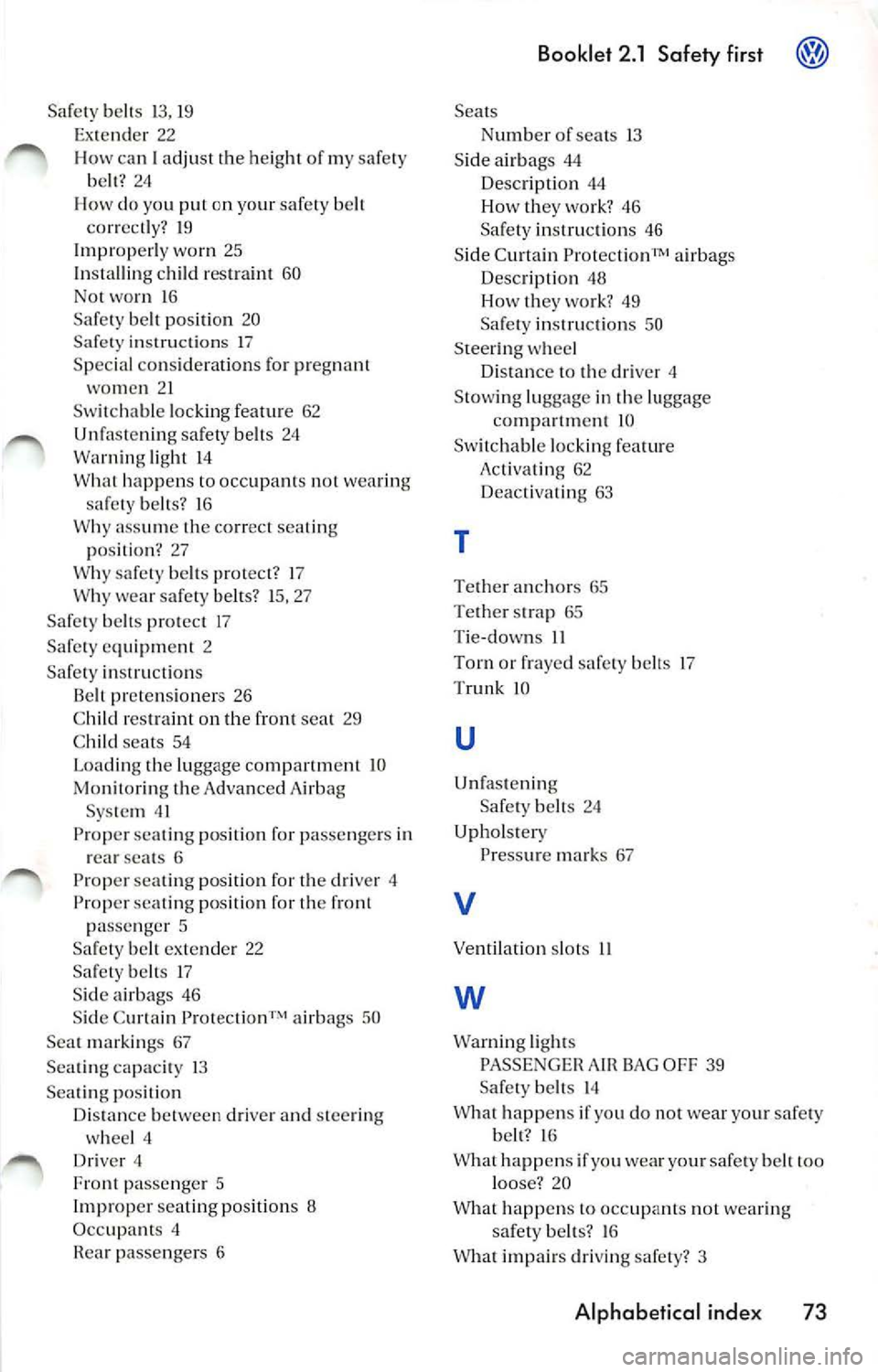
Safet y belts 13, 19
Ex tende r 22
H ow can I adjust the height of m y safe ty
b elt ? 24
I - l ow d o you put on yo ur safe ty belt
cor re ctly? 19
Im properl y wo rn 25
In sta lli ng child res traint 60
No t wo rn 1 6
Safety be lt po sit io n 20
Safety i nstru cti ons 17
S pec ial co nsid erations for pregnan t
wo men 21
Sw itchab le locki ng feat ure 62
safet y belt s 24
Warn ing light l4
Wha t hap pens to occupa nts not wea ring
sa fe ty belts? 16
Why a ssum e th e corr ect sea ting
p osi tion ? 27
Why safety be lts protect? 17
Why wear safety belt s? 15, 27
Sa fe ty be lts pro tec t 17
Safe ty e quip ment 2
Safe ty in stru ctions
Be lt pre ten sioner s 26
C hil d res traint on th e fro nt sea t 29
C hild seats 54
Lo ad ing the luggage comp artm ent 10
Mo nitoring t he Advanced Air bag
Sys tem 41
Prop er se ating posit io n fo r pa sse ngers in
r ea r sea ts 6
Proper seating positio n for t he dri ve r
Prop er se ating posit ion for th e fron t
p ass en ge r 5
Sa fe ty belt exte nder 22
S af ety b elts 17
S ide a irbags 46
S id e C urtain Protectio n
airbags 50
Sea t marki ngs 67
Sea ting capac ity 13
S eatin g po sit ion
Di stance betw een driver an d stee rin g
w hee l 4
D riv er 4
Fro nt passe nger 5
Im prope r se ating posit io ns 8
Occ upa nts 4
R ea r pa sse ngers 6
Booklet 2 .1 Safety first
Sea ts
N umber of seats 13
S id e a irb ags 44
Description 44
H ow they wo rk? 46
Sa fety instruction s 46
S id e C urtain Prot ectio nT M a irbag s
Desc ription 48
Ho w they wo rk ? 49
Sa fe ty in stru cti ons 50
S teer ing w hee l
Di sta nce to th e dri ve r 4
Stow ing lug gage in the lugg age
c ompartm ent 1 0
Sw itchabl e lo ck in g fea ture
Act iv ating 62
Deactivating 63
T
Tether an ch or s 65
T ether stra p 65
T ie-dow ns 11
T orn or frayed safety belt s 17
T runk
IQ
u
Unfa ste ni ng
Safe ty be lts 24
U phol stery
Pre ssur e ma rks 67
V
Ve ntil ati on slo ts
w
Warn ing lig ht s
PA SSENGE R AIR BAG OF F 39
Safety belts 14
Wha t happe ns if yo u do no t wea r yo ur safe ty
b elt ? 16
W hat happ ens if yo u w ear your safe ty heir to o
l oose '? 20
What happen s to occupants not wea rin g
sa fe ty be lts? 16
W hat im pairs dri ving safe ty ? 3
Alphabetical inde x 73
Page 204 of 477

Booklet 3.1 Controls and Equipm ent ®
Table of contents
Instrument panel ........... .. .. ... .
Overview .............................. .
Overview of the contro l butto ns on the
mu lti- function steering w heel ..... .... . . .
Instrument cluster ...... ............. ... . .
Display in the in strument cluster ......... .
Menus in the instrument cluster ..... •.. ..
Warning lights .... ....... ........ ..... . .
2
2
4
5
7
12
20
Op ening and closing Keys . . . . . . . .
31
K ey Set . . . . . . . . . . . . . . . . . . . . . . . . . . . . . . . . . . 31
Remo te cont rol key . . . . . . . . . . . . • . . . . . . • . . 32 C ent ral locking system . . . . . . . . . . . . . . . . . . . 34
Anti-the ft o lorm system . . . . . . . . . . . . . . . • . . 36
Rear lid . . . . . . . . . . . . . . . . . . • . . . . . . . . . . . . . . 37
Windows .... .. . . .. .... ... . .... . .. .. .. . .
39 Po wer roof . . . . . . . . . . . . . . . . . . . . . . . . . . . • . . 42
H ome link® Universal Transm itter . . . . . . . . 44
Lights and a clear view . . . . . . . . . . . 46
Lights . . . . . . . . . . . . . . . . . . . . . . . . . . . . . . . . . . . 46
Interior lights . . . . . . . . . . . . . . . . . . . . . . . . . . . . 50
Clear vision . . . . . . . . . . . . . . . . . . . . . . . . . . . . . 52
Windshie ld wi pers . . . . . • . . . . . . . . . . . . . . . . 53
Mirrors . . . . . . . . . . . . . . . . • . . . . . . . . . . . . . . . . 55
Seat s and storag e . . . . . . . . . . . . . . . . . . 57
Why is seat adjust ment so im portant ? . . . . 57
H ead restraints . . . . . . . . . . . . . . . . . . . . . . . . . . 58 Front seats .
..... .... ... •..... .• .... .....
Rear seat bench . ... ...... ....... •.. .... .
Sto rage ......... ................... .... .
Additiona l storage comportmen t ond
elec trica l sockets .... ... .... .... ... ...... .
Luggage comportment ........... ....... .
R oo f rock . .......... ......•.... .. •.......
Air conditioning system ...... ... .. . 60
66
69
73
74
76
80
Heal
ing . . . . . . . . . . . . . . . . . . . . . . . . . . .. . . . . . 80
Cl imatic . . . . . . . . . . . . . . . . . . . . . . . . . . . • . . . . . 8 1 Climotronic . . . . . . . . . . . . . . . . . . . . . . . . . . . . . . 84
Im portan t no tes . . . . . . . . . . . . . . . . . . . . . . . . . 88
Driving ................... ............. 90
Steering . . . . . . . . . . . . . . . . . . . . . . . . . . . . . . . . . 90
Safety . . . . . . . . . . . . . . . . . . . . . . . . . . . . . . . . . . . 91
Igniti on lock . . . . . . . . . . . . . . . . . . . . . . . . . . . . . 93
Starting ond stopping the engine . . . . . . . . . 95
Monuol transmission . . . . . . . . . . . . . . . . . . . . . 97
Automatic transmissio n
I Direct sh ift
gea rbox . . . . . . . . . . . . . . . . . . . . . . . . . . . . . . . . . 98
P arking brok e . ...... .... .... .. .. .. . .. ...
104 Electronic Parking Assistance . ........ •.. . 10 6
Crui se co ntrol ......... ........ .... ...... 107
Alphabetical inde x .... ...... .... ... 10 9
T ab le of contents
Page 260 of 477
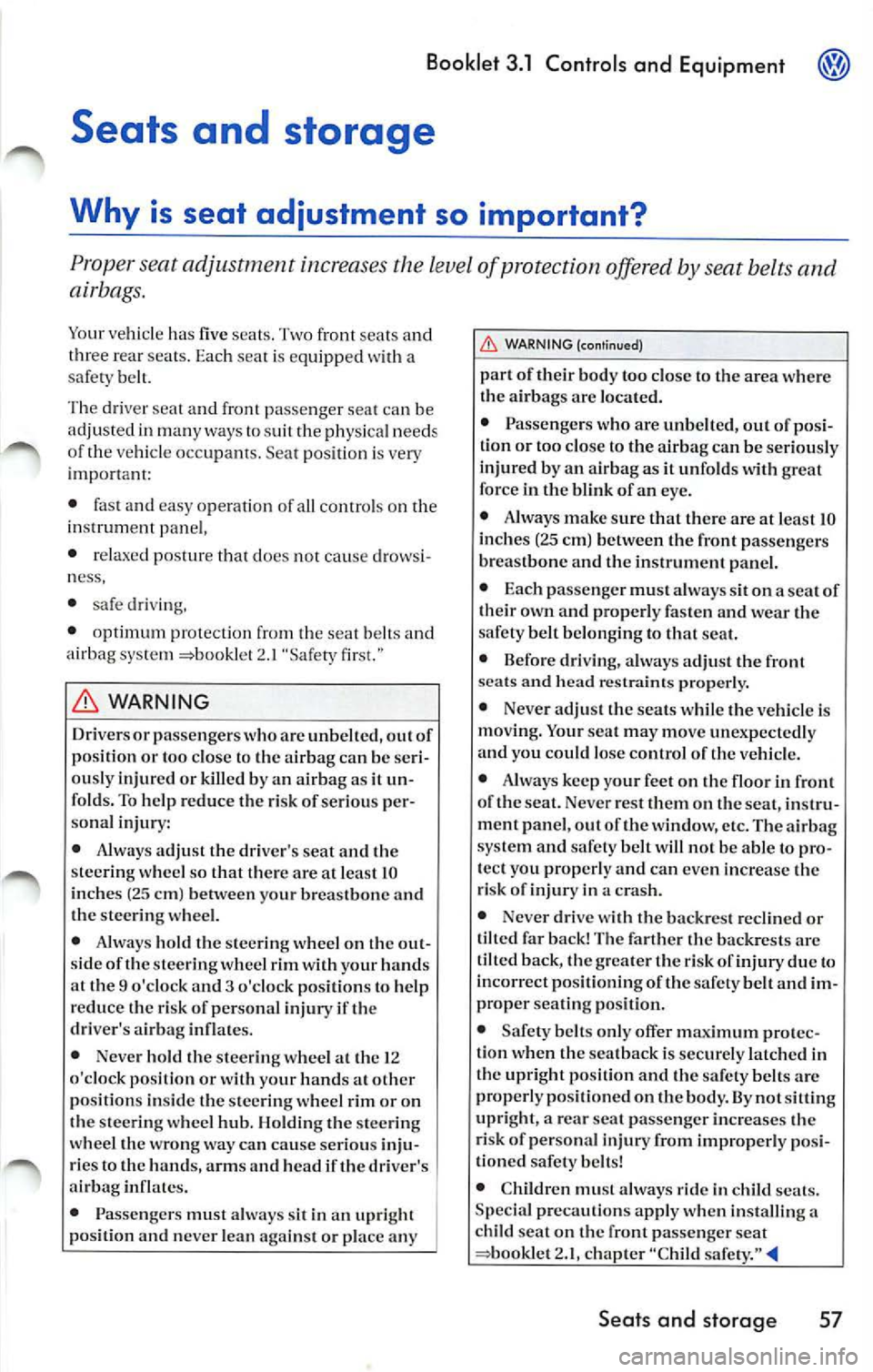
Booklet 3.1 Controls and Equipment
a
safety belt.
Th e dri ver sea t and front pa ssenger seat can be
adjusted in many ways to sui t the physi cal need s
of the ve hicle occupams . Seat position i s very
i mporta nt:
• fast and easy operation of all control s on th e
in strum ent panel,
• relax ed posture that does not ca use drow si
ness,
• safe driving,
• opt imum protection from the seat belts and
airbag syste m
2.1 "Safety fir st."
WARNING
Drivers or passe ngers who arc unbelted , out of
position or too close to the airbag can be seri
ously injured or killed by an airba g as it un
folds. To help reduce the risk of ser iou s per
so nal injur y:
• Alwa ys adjust the driver's seat and the
s teering wheel so that th ere a re at least 10
inches (25 cm) betwe en yo ur breastbone and
the steeri ng w heel.
• Alwa ys hold th e steer ing wheel on th e out
s id e of the s teer ing wheel rim with your hand s
at the 9 o'clock and 3 o'clock positions to help
reduce the risk of personal injury if the
driver 's airbag inflates.
• Neve r hold th e steer ing wheel at the 12
o'clock position or with your hands at other
pos ition s in sid e the steer ing w hee l rim or on
the steer ing wheel hub. Holding the ste ering
w hee l th e wrong way can cause serio us inju
ries to the h ands, ar ms and head if the driver's
airbag inflates.
• P assengers must alway s sit in an upright
po sitio n and ne ver lean against or place any ,0.
WARNING
(continued)
part of th eir body too close to the area where
the airbags arc located.
• Passengers who are unbelt ed, out of posi
tion or too close to the airbag can be seriously
injured by an
as it unfo lds with great
force in the blink of an eye.
• Always make sure th at there arc at least 10
in ch es (25 cm) between the front passeng ers
breastbone and the instrum ent panel.
• Each passenger must always sit on a sca t of
th eir ow n and properly fasten and wear the
safety belt belonging to that seat.
• Before driving, a lways adjust the front
seats an d head restra ints pr operl y.
• Neve r adjust the seats while the vehicle is
moving. Your scat may mo ve unexpectedl y
and you could lose control of the vehicle .
• Always keep your feet on the floor in front
of the scat. Neve r rest them on the seat, instru
m ent panel, out of the window, etc. The airbag
s ystem and safety belt will not be able to pro
t ect you properl y a nd can even increase the
ri sk of injur y in a crash.
• Never drive with the backrest recl ined or
tilt ed far back! The farther the backrests arc
tilt ed back, the greater the risk
due to
in cor rect positionin g of the safety belt and im
proper seating position.
• Safety belts only offer max imum protec
ti on wh en th e sea t back is sec urely latched in
th e upri ght position and the safety belts arc
proper ly positioned on the bod y. By not sitting
upright, a rear scat passenger increase s th e
r is k of per sonal injury from improperly pos i
ti oned safet y belts!
• Children must always ride in child seats.
Specia l precautions apply when insta lling a
child scat on the front pas senger sea t
2.1, ch ap ter "Chi ld
Seats and storag e 57
Page 261 of 477
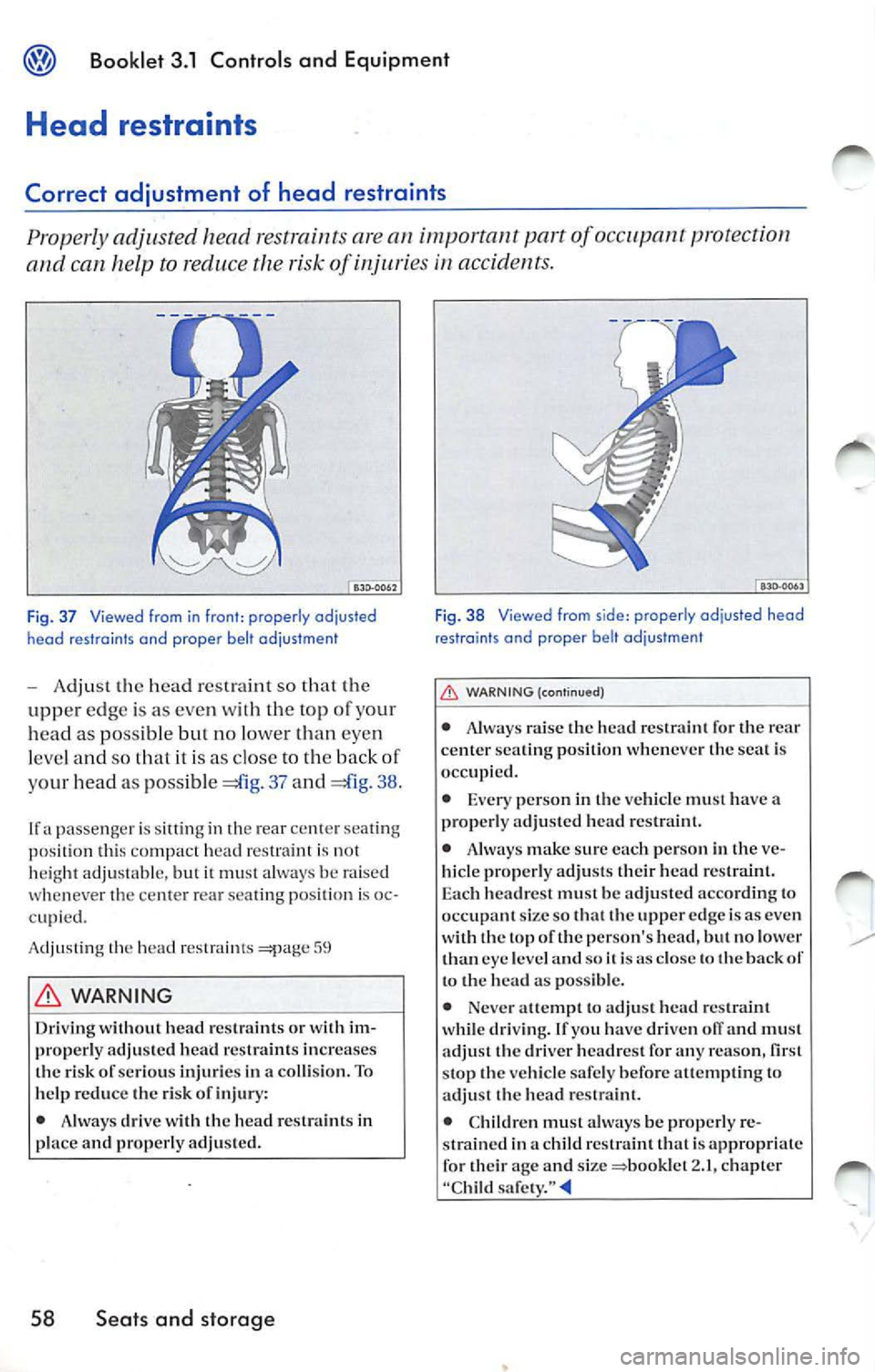
Booklet 3.1 Controls and Equipm ent
Head restraints
Correct adjustment of head restraints
Properly adjusted h ead restraints are an importa 11t part of occupant protection
and can help to reduce the risk of
in accidents.
Fig. 3 7 Viewed from in front : properly odjusted
heod restraints end proper belt odjustment
- Adjust the head restraint so that the
uppe r edg e is as eve n wit h th e top o f your
head as possible
no lo wer than eyen
l eve l and so th at it is as close to th e bac k of
y our head a s possi ble
37 and 38.
If a passenger is s itting in th e rear center sea tin g
position thi s co mpact h ead r estraint is no t
h eight adju stabl e, but it must always be raised
whenever the ce nte r rear sea ting posi tion is oc
c upi ed.
A dju sting the head
WARNING
Driving without head rest raints o r wit h im
prop erly adjusted head restraints inc reases
th e risk of serious injurie s in a co llision. To
h elp reduc e th e risk of injury:
• Always drive with th e head restraints in
place a nd properly adjuste d.
58 Seats and storage
F ig . 38 Viewed from s ide: properly adjusted head
restraints and proper belt ad justment
WARNING (contin ued)
• Always raise the head restrai nt for the r ear
center seating position wheneve r the seat is
occupied.
• Ever y perso n in th e ve hicle must have a
properl y adjuste d head r estra int.
• Alway s make sur e eac h person in the ve
hicle properly adju sts their head restraint.
E ac h headres t must be adjusted a ccord ing to
occupant size s o that the upper ed ge is as eve n
wit h the to p of the person's head, but no lower
tha n eye leve l an d soi
is as clo se th e back to the head as pos sibl e.
• Neve r attempt to adj ust head r estraint
wh ile dri vin g. If yo u have driven
and mu st
adjust the driver h eadrest for any reason,
stop the ve hicle safe ly befo re atte mptin g to
ad just the head r estra int.
• Children must always be properly re
s trained in a ch ild restrain t that i s appropr iate
for their age and size
2. 1, ch apter
"Chil d safety. "